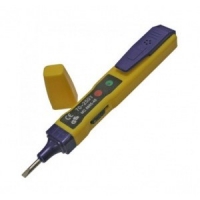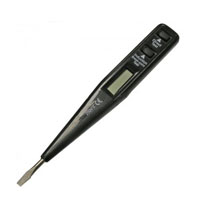 In this article, we decided to talk about such a tool as a tester screwdriver. Almost every person who has encountered the work of installing electrical wiring, replacing electrical wiring, installing a new electrical outlet, etc. know what instrument it is.
In this article, we decided to talk about such a tool as a tester screwdriver. Almost every person who has encountered the work of installing electrical wiring, replacing electrical wiring, installing a new electrical outlet, etc. know what instrument it is.
In the classic view, this is a small screwdriver, inside of which there is a small LED that shows whether there is a phase on the wire that you touch with this tool. Accordingly, the second wire in the same outlet will be zero. It can only be determined using the elimination method.
Classic screwdriver testers are designed for use in AC 220 volts. This is the normal voltage for a household electrical outlet. For the convenience of using a screwdriver with a tester, there is a special clip on the handle - a clip. Electricians usually cling it to their breast pocket so that, firstly, they don’t lose it, and secondly, it is always at hand - very convenient.
Using this tool is very easy. To do this, you need to touch the bare wire with the tip of a screwdriver, while pressing one of your fingers on the end of the handle. If the wire is phase, an LED lights up inside the hollow handle, which is made of transparent plastic material. If the light does not light up, the wire is zero.
Modern screwdriver testers in the classic version can be used in electrical networks with voltages from 100 volts to 500 volts. The screwdriver shaft is made of chrome vanadium steel and has a flat tip. With this tool, you can tighten bolts and screws of small sizes under a flat screwdriver. Usually they are screwed with screws when fixing the wires inside the outlet, installing various terminals, etc. Low-quality screwdriver testers (usually they can be distinguished at a low price) use soft steel and they “lick” very quickly.
The following model can be cited as a classic tester screwdriver: Indicator screwdriver Energy 6875-17150
The principle of operation of the tester screwdriver
The principle of operation is quite simple. When you touch a wire that has a phase with the tip of a screwdriver, a current begins to flow through it, which passes through a resistor (it looks like a glass cone with wires inside) and lights up the LED bulb. Further, the current passes through the arm and through the human body goes into the ground. For a person, this is not dangerous, since the resistance of a screwdriver is very large and a current of such low power passes through a person that it is simply not felt.
Other types of modern screwdriver testers
In addition to the classic tester screwdriver, taking into account the development of technology and technical progress, mankind has been able to create more functional options. With their help, in addition to the main purpose of determining the phase wire, many more different works can be carried out. So with their help, you can determine the integrity of the electrical circuit, determine the places where the wire breaks inside the walls, find the places where the wires under the current are laid under the plaster, determine the voltage values, as well as the polarity of the batteries in the batteries.
All this is done with just one tool - a tester screwdriver. Modern screwdriver testers can be used for electrical networks of a wide variety of voltages from 12 volts to 500 volts. Tester screwdrivers with additional functions already require additional power supplies to operate.
Next, we will describe several types of such screwdrivers so that you have an idea about them.
First, let's talk about screwdriver testers with a display. As an example, take a screwdriver Energy 6878-28NS .
With this tool, you can also carry out additional measurements of AC and DC. It can also be used to determine in a non-contact way where the wires are laid inside the wall. The screwdriver has an LCD display, which shows the presence of voltage (there is a phase or not), as well as the magnitude of the effective mains voltage. With this screwdriver, you can determine the network with a voltage of 12V, 36V, 55V, 110V and 220V. The maximum allowable mains voltage for using this type of tester screwdriver is 250 V, with a frequency of 50 to 500 Hz. Batteries are not required for this type of screwdriver.
Another type of modern tester screwdrivers is indicator screwdrivers with a sound signal. Let's talk about them using the example of a screwdriver indicator Energy 6885-48NS .
 This screwdriver, in fact, has the same characteristics as the previous model. However, it has several modes of operation. In particular, this model has three modes:
This screwdriver, in fact, has the same characteristics as the previous model. However, it has several modes of operation. In particular, this model has three modes:
1. Voltage detection by contact method. The analysis is carried out by the LED indicator. The sensitivity level is low.
2.Non-contact voltage detection in the network. Both a light indicator and an audible signal are used for the signal. The level of sensitivity is average.
3. Non-contact detection of mains voltage. Both a light indicator and an audible signal are used for the signal. The sensitivity level is high. As an additional power source in these screwdriver testers, batteries of the LR44 type with a voltage of 1.5 V are used. The specified model of the tester screwdriver can be used with a contact method for networks with a voltage of 70 to 250 V, and with a non-contact method from 70 to 1000 V.
The built-in beep is a very useful feature of modern tester screwdrivers. This is especially important when repairing electrical wiring on the street in sunny weather. The fact is that in the sun, due to the weak glow of the LED, it is very difficult to determine whether it is on or not, even if you cover the tester with your hand from the light. But you will always hear the sound.
In addition to the described varieties on sale, you can find a large number of transitional models, between the classic version and fancy models. Usually this is practically a conventional screwdriver tester with the possibility of non-contact voltage detection. They are usually much cheaper than their sophisticated counterparts, but we do not recommend buying them. Since they do not have several operating modes, they have one setting, and as a rule, very sensitive. These screwdrivers are very strongly affected by inducing currents.
That is, in fact, even if you bring a screwdriver closer to a recently de-energized wire, the indicator still lights up, which is misleading. In general, we recommend either using the classic version or fancy options.
|
Useful articles |
